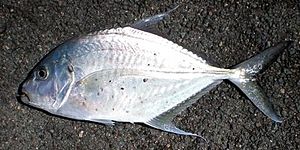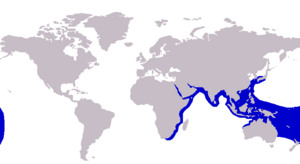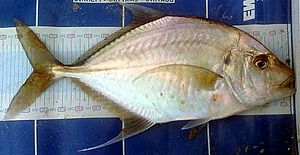Longnose trevally facts for kids
Quick facts for kids Longnose trevally |
|
|---|---|
 |
|
| Conservation status | |
| Scientific classification | |
 |
|
| Approximate range of the longnose trevally | |
| Synonyms | |
|
The longnose trevally (Carangoides chrysophrys) is a cool fish with a few different names! People also call it the tea-leaf trevally, club-nosed trevally, grunting trevally, or dusky trevally. It's part of the jack family called Carangidae. This fish lives in the warm, tropical waters of the Indian Ocean and the western Pacific Ocean. You can find it from South Africa all the way to New Zealand and Japan.
These fish love coastal areas, especially reefs, and can be found as deep as 90 meters. The longnose trevally is special because of its unique scaleless chest and the number of gill rakers it has. It's a pretty big fish, growing up to 72 centimeters long and weighing over 4 kilograms. The longnose trevally is a predator, which means it hunts and eats smaller fish, crustaceans like crabs, and molluscs like snails. People sometimes catch them for food, and they are considered good to eat!
Contents
What Makes the Longnose Trevally Special?
The longnose trevally looks a lot like other jack fish. When it's young, it's shaped like an oval, but as it gets older, it becomes more oblong. It can grow quite large, up to 72 centimeters (about 2.3 feet) long and weigh around 4.35 kilograms (about 9.6 pounds).
One of the easiest ways to tell this fish apart is its snout. The top of its head slopes gently, but then it suddenly drops straight down right before its mouth. Both of its jaws have many small teeth. Older fish might even have some bigger, cone-shaped teeth.
This fish has two dorsal fins on its back. The first one has 8 stiff spines, and the second has 1 spine and 18 to 20 soft rays. Its anal fin (on its belly) has two separate spines, followed by 1 spine and 14 to 17 soft rays. The long pectoral fins are shaped like a sickle.
A cool fact about the longnose trevally is that its chest doesn't have scales! This smooth area goes all the way up to its pelvic fins and out to the base of its pectoral fins.
Colors of the Longnose Trevally
Longnose trevallies are usually silver. Their bodies and heads are greenish-blue on top, and then they become silvery with yellow-green colors underneath. They have a small black spot on the top edge of their gill cover.
Their dorsal and anal fins can be white, pale yellow, or a bit dark. The soft rays of the anal fin often have a white spot at their base. The caudal (tail) and pectoral fins are usually pale to dusky yellow. Sometimes, very large adult fish can have super dark heads and fins, almost black! This might happen when they are getting ready to mate or spawn.
Where Do Longnose Trevallies Live?
The longnose trevally lives in warm, tropical and subtropical waters. You can find them in the Indian Ocean and the western Pacific Ocean. Their home range stretches from South Africa and Madagascar in the west, north to the Red Sea and Persian Gulf, and east to India, Southeast Asia, Indonesia, Japan, and all the way to Fiji. They are also found as far north as Okinawa, Japan, and as far south as northern Australia and New Zealand.
These fish are inshore creatures, meaning they stay close to the coast. They usually hang out around coastal reefs and sometimes in big, protected bays. They can handle water that's a bit cloudy, which is unusual for their relatives. Young trevallies often live in shallow bays near the coast and can even be seen near beaches. Adult fish prefer deeper water, usually between 30 and 60 meters, but they've been found as deep as 90 meters.
What Do Longnose Trevallies Eat?
The longnose trevally is a predator that hunts for food on or just above the seafloor. Scientists have studied their diet in places like the Gulf of Carpentaria in Australia. They found that these trevallies mostly eat small fish. They also enjoy a good meal of molluscs, crabs, and other crustaceans. In South Africa, it's thought that they really like prawns, along with crabs and small fish. Because they have a fairly soft mouth, it might affect what kind of food they can catch and eat.
Fishing for Longnose Trevallies
The longnose trevally is not a super important fish for big fisheries, but people do catch them. They are caught using fishing lines, bottom trawls (nets dragged along the seafloor), gill nets, and different kinds of traps. When they are sold, they are usually fresh and often grouped with other similar fish.
Sometimes, people who fish from boats or even from the beach in South Africa catch longnose trevallies. They are known to bite small baits and are considered tasty to eat!
Images for kids
See also
 In Spanish: Carangoides chrysophrys para niños
In Spanish: Carangoides chrysophrys para niños






